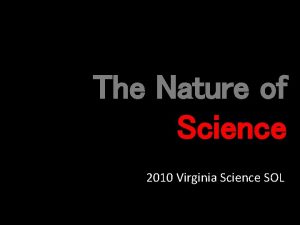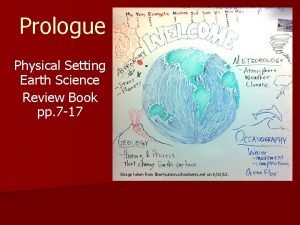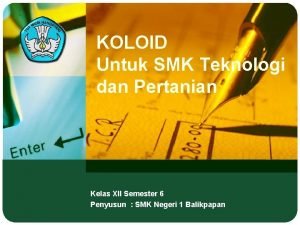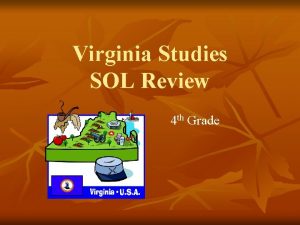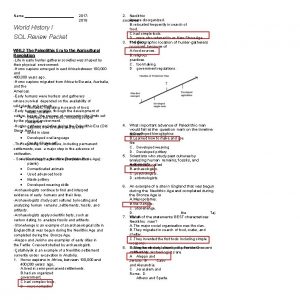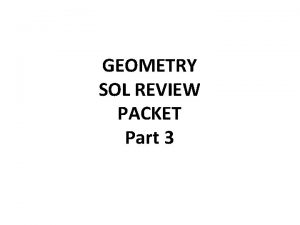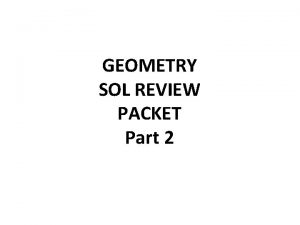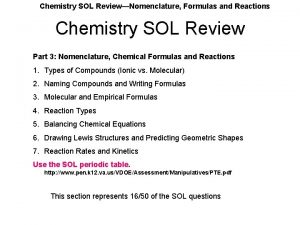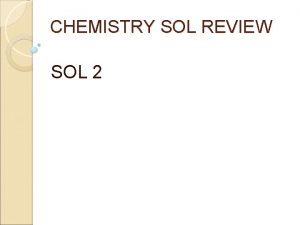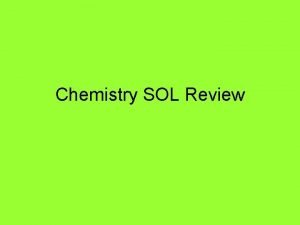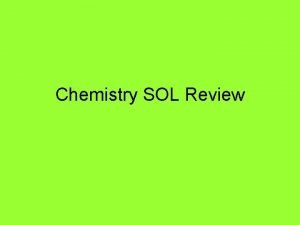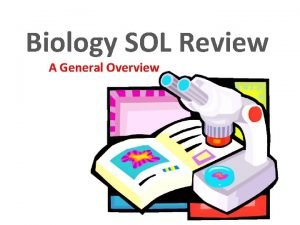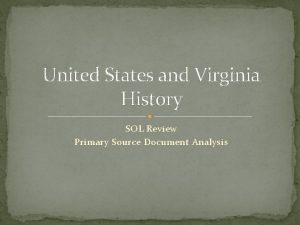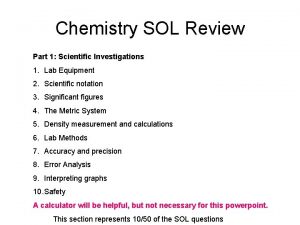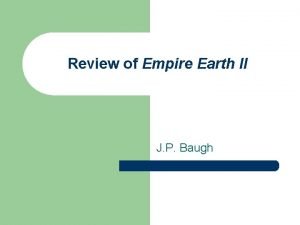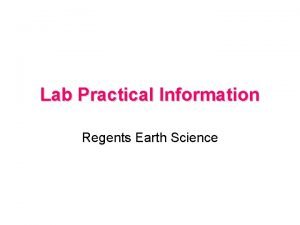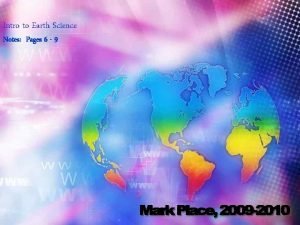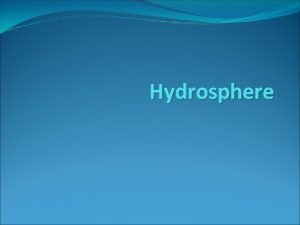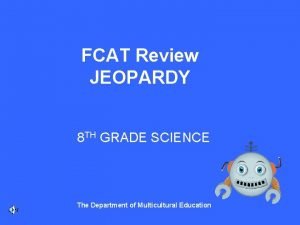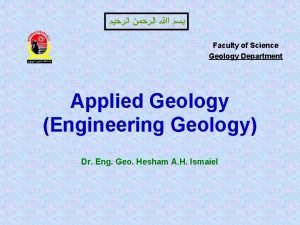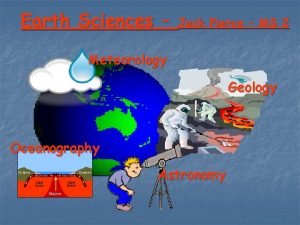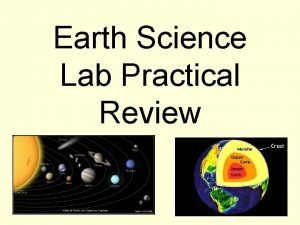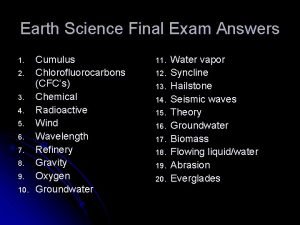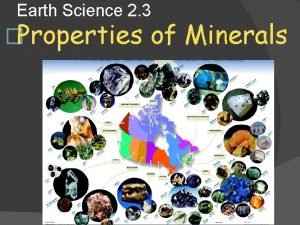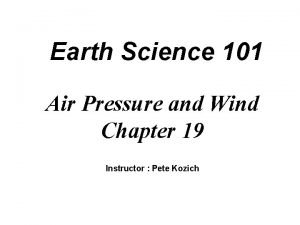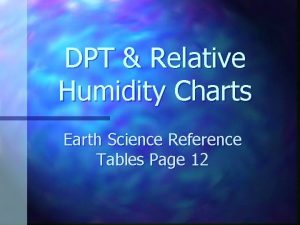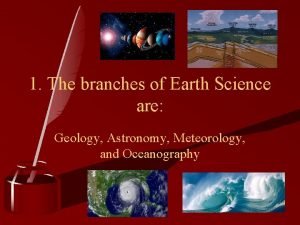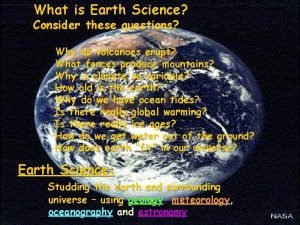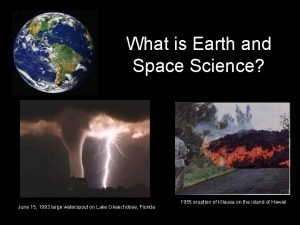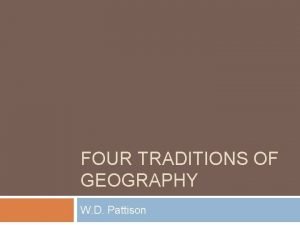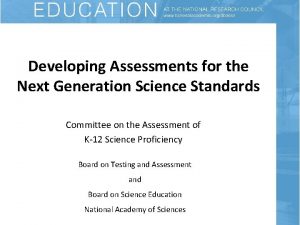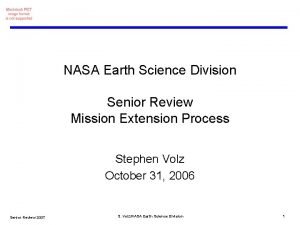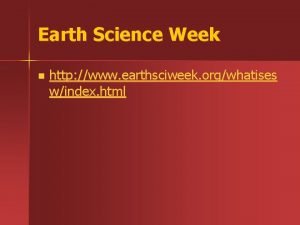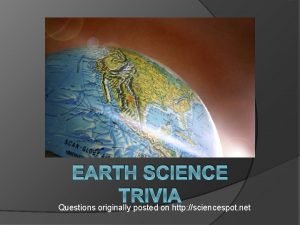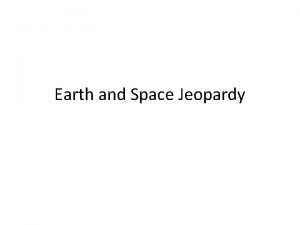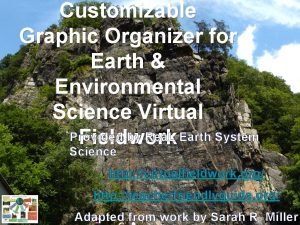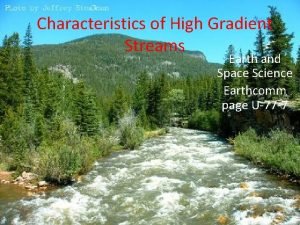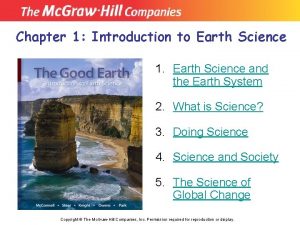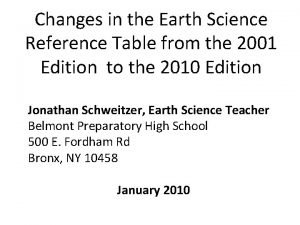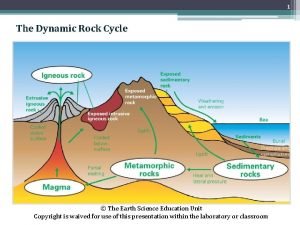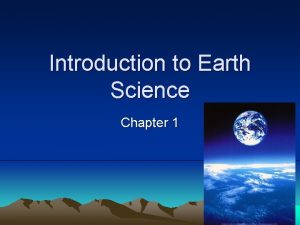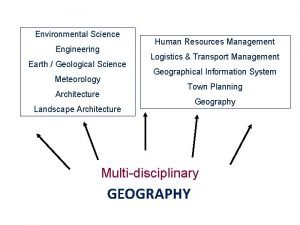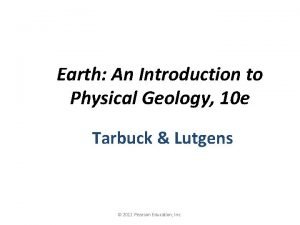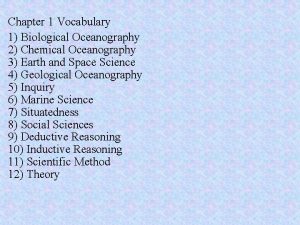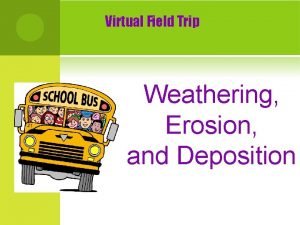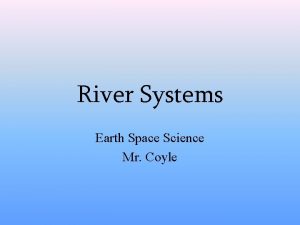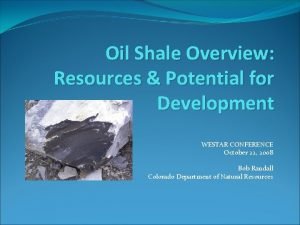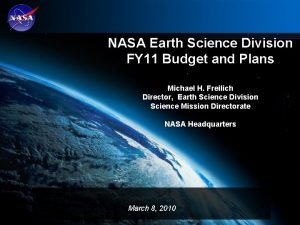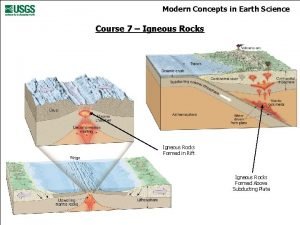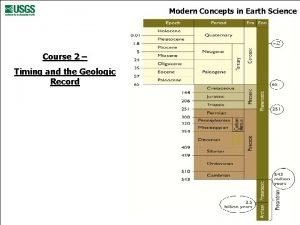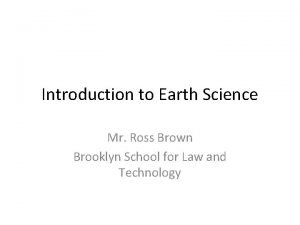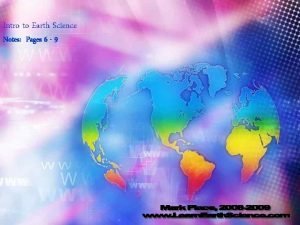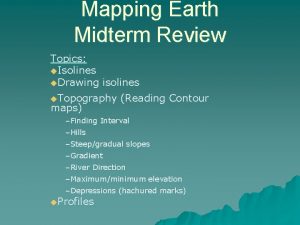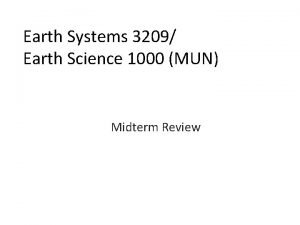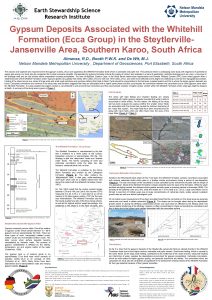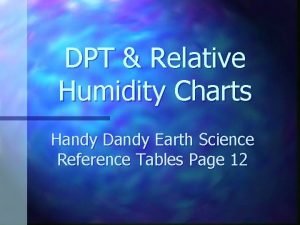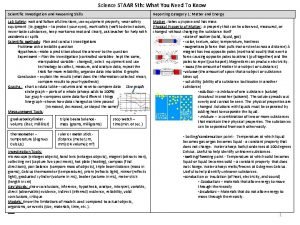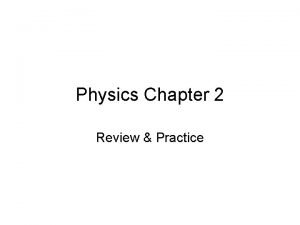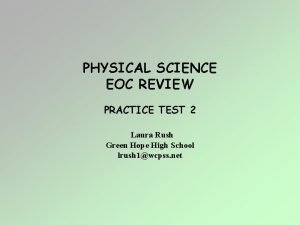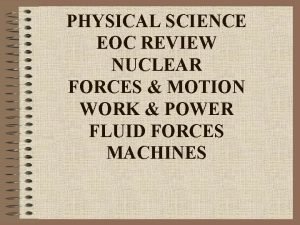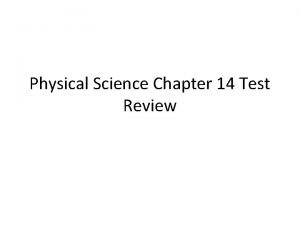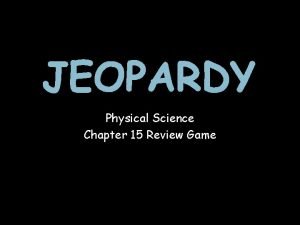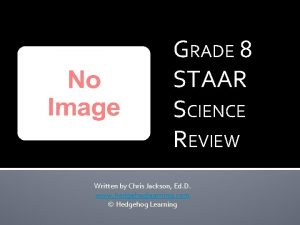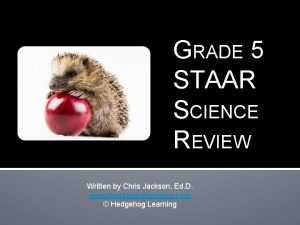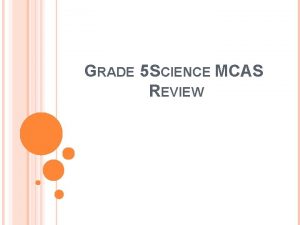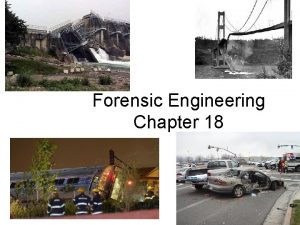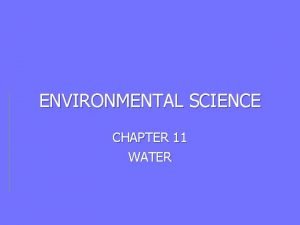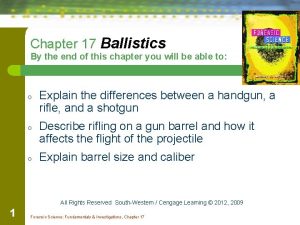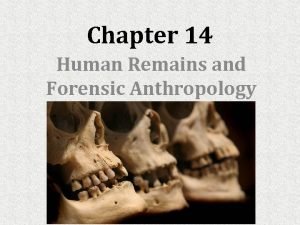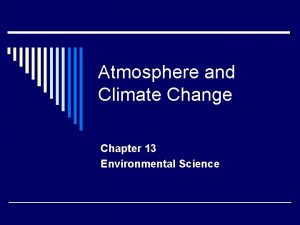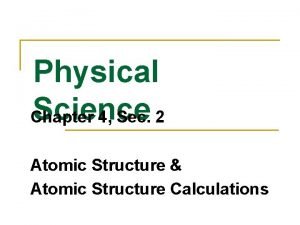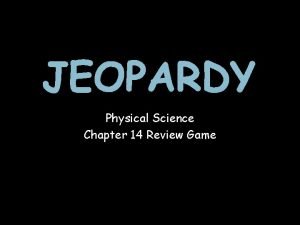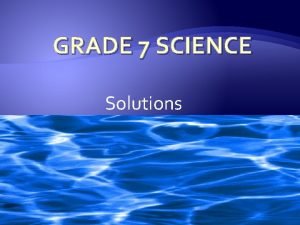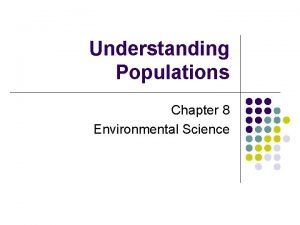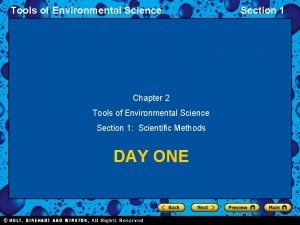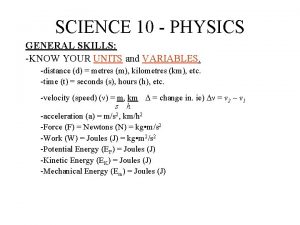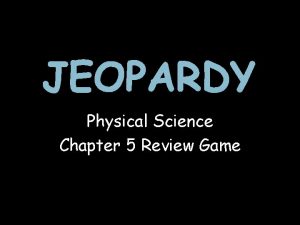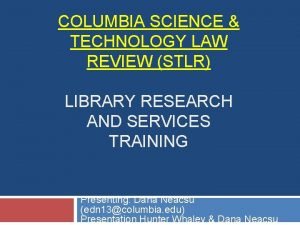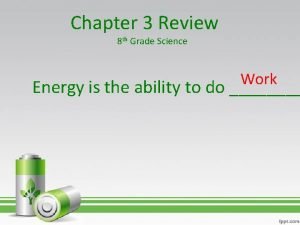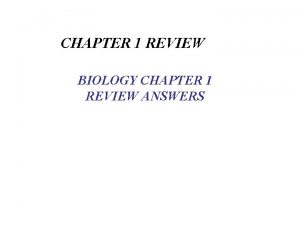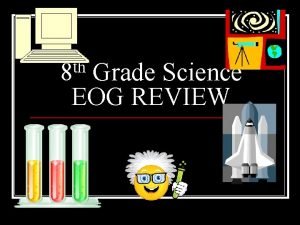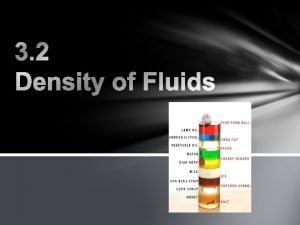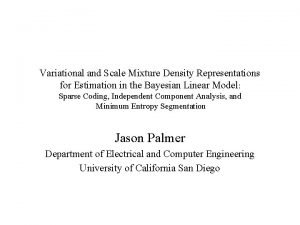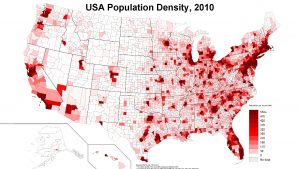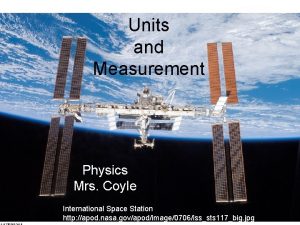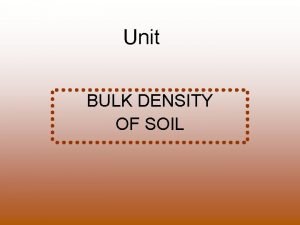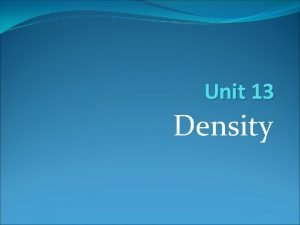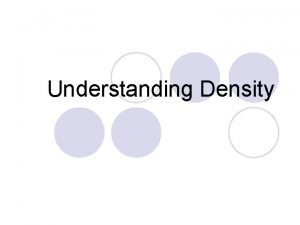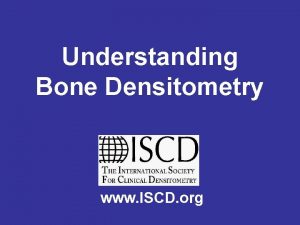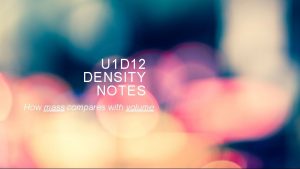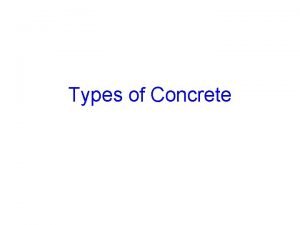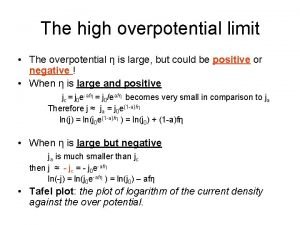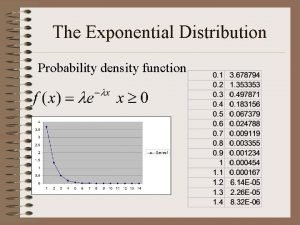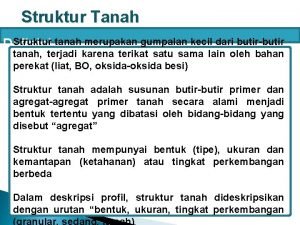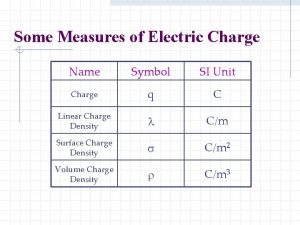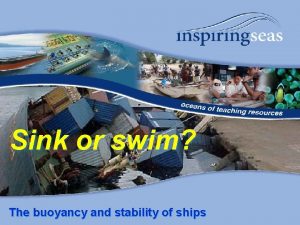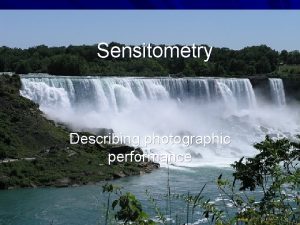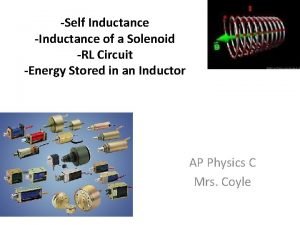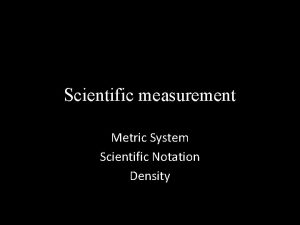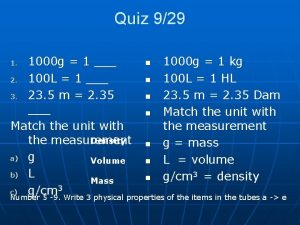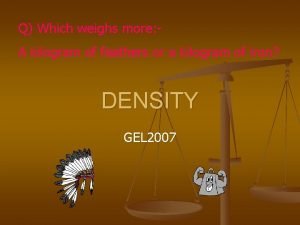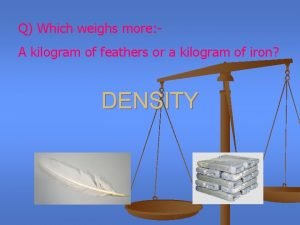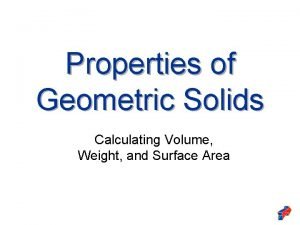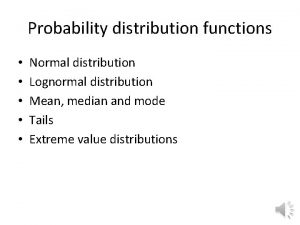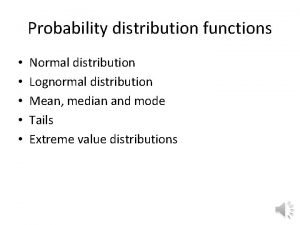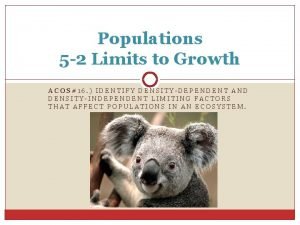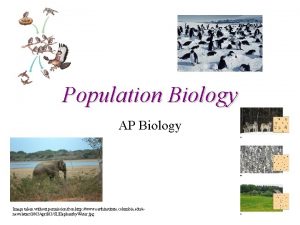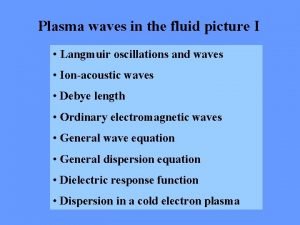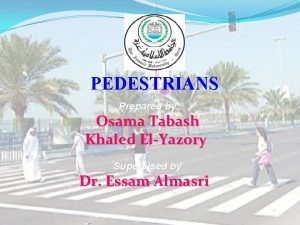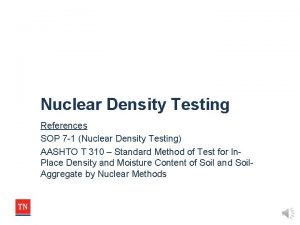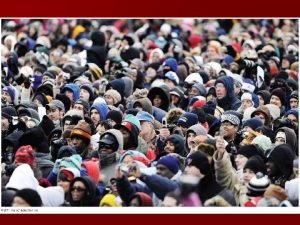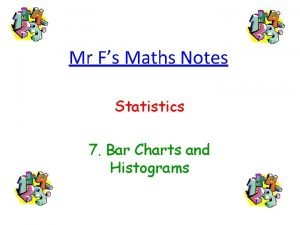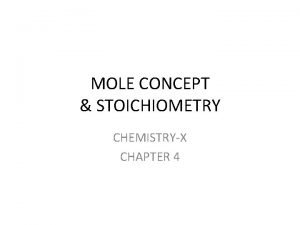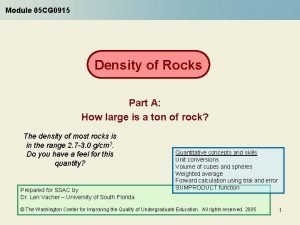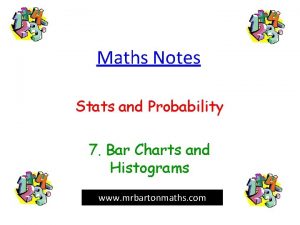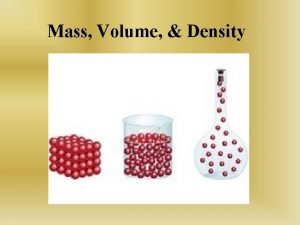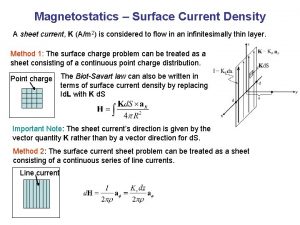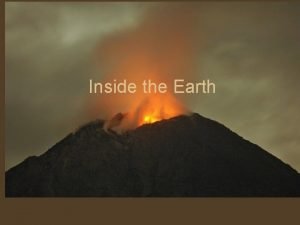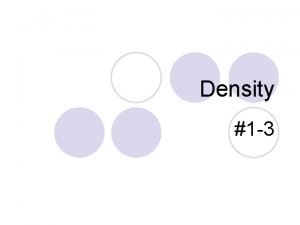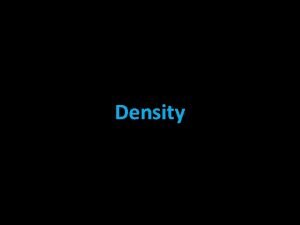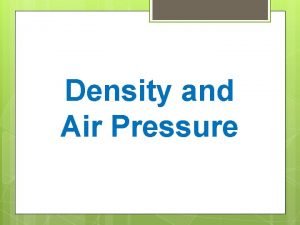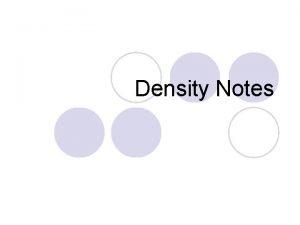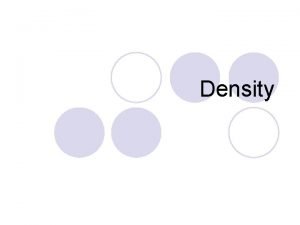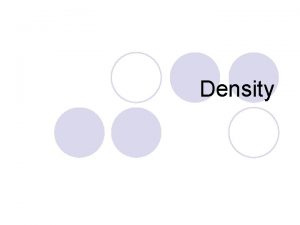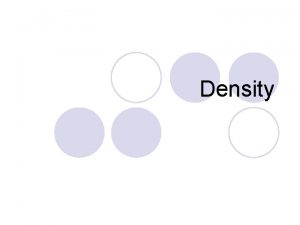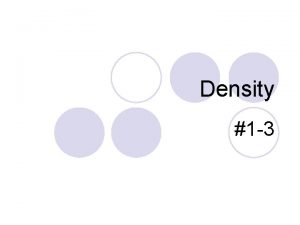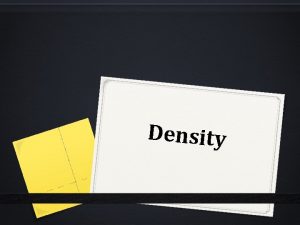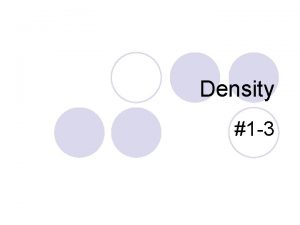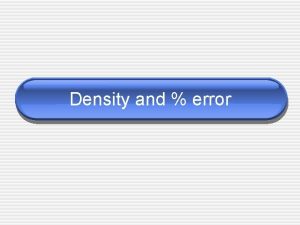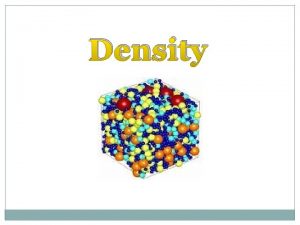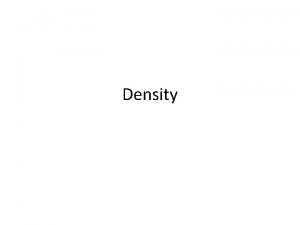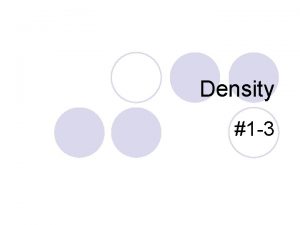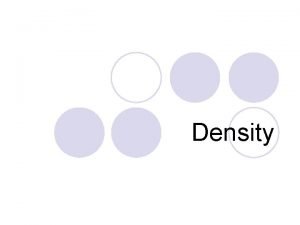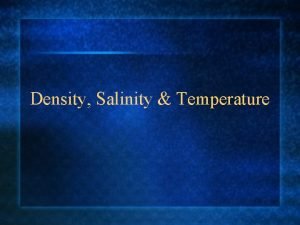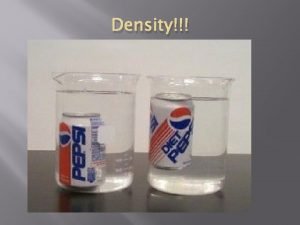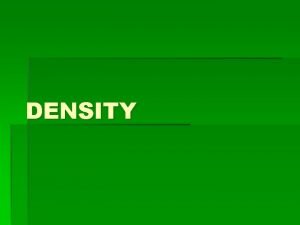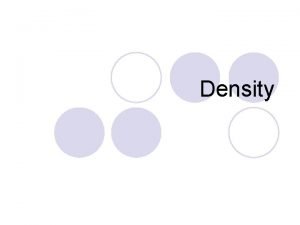Earth Science SOL REVIEW SOL ES 1 Density















































































































































































- Slides: 175

Earth Science SOL REVIEW

SOL ES 1 Density Relationship between mass and volume D = m/v Density is always given as g/ml or g/cm 3 Mass can be determined by using a scale or triple beam balance Volume is determined by using a graduated cylinder

Temperature decreases with depth Density increases with depth Pressure also increases with depth Salinity increases with depth

Atmosphere Temperature and Pressure

The troposphere is the lowest layer of the atmosphere and is where all weather occurs The stratosphere is the second layer of the atmosphere. This layer contains the ozone which is responsible for blocking some forms of UV radiation from reaching the earth.


Topographic Maps

Topographic Maps Measure changes in elevation A profile is a side view of an elevation When contour lines are close together, the area is steep. Contour lines always point upstream (opposite of flow) Depressions or holes are identified by lines within a circle Valleys will have contour lines very spread apart

7. 5 Quadrant (Minute) Topographic map


Latitude N and S of Equator Longitude E and W of the Prime Meridian

SOL ES 2 Scientific Method Scientists use observations of phenomena to make predictions of future events and explain what has happened in the past Hypothesis �Tentative explanation �Only hypotheses that are testable are valid Theories offer explanations for observed patterns in nature Laws describe patterns and relationships in nature and are based on data that has been observed

Observations are made using the senses Inferences are not based on observations. They are conclusions made on data that is known to be true Variables Independent �Variable changed in an experiment �Should only be one Dependent �Variable measured in an experiment

Scientific Laws and Theories Plate tectonics �Convergent, divergent, transform Superposition �Youngest on top, oldest on bottom Uniformitarianism �Processes today are same as in the past Original horizontality �All rock layers are originally laid down horizontally Cross cutting �An intrusion or fault is younger than the rock it cuts through

Continental drift �Matching fossils, rock types, mountain ranges, and changes in climate Seafloor spreading �Divergent boundary on ocean floor was the mechanism for movement of continents Big bang theory �Formation of the universe Solar nebula theory �Formation of the solar system �Sun formed first �Solid inner planets – able to withstand heat, more dense material, settle out first �Gaseous outer planets – moved to distant parts of the solar system due to solar wind Formation of the moon �Asteroid impact with earth

SOL ES 3 Earth Third planet from the sun Solid inner planet Consists of layers �Crust – lithosphere (oceanic and continental crust) �Mantle – asthenosphere �Outer core and inner core One satellite – the moon Water occurs in three forms due to position in solar system �Solid, liquid, and gas Only planet to support life as we know it due to oxygen in the atmosphere and liquid water

Earth along with the other planets revolves around the sun in paths called ellipses The earth’s axis is tilted. This tilt is responsible for the amount of solar energy reaching the earth’s surface and the seasons The rotation of the earth on it’s axis causes days and nights The tilt of earth’s axis is responsible for duration of days and nights


The moon revolves around the earth causing moon phases and eclipses The tides are caused by the gravitational pull of the moon and sun There are 2 types of tides: spring and neap


Full moon phase New moon phase

Parts of an eclipse Umbra Dark part of the moons shadow Complete eclipse Penumbra Light part of the moons shadow Partial eclipse

New and Full moons 1 st and 3 rd Quarter moons

Sun The sun is a main sequence star Consists mostly of hydrogen Energy is produced by nuclear fusion of hydrogen to helium

The Planets Inner terrestrial Smaller Solid Higher densities Thinner atmospheres �Mercury – none �Venus – thick, CO 2 �Earth – nitrogen, oxygen, argon �Mars – Thin, CO 2 Faster orbital periods Slower periods of rotation Few natural satellites Outer Jovian Larger Gas giants possibly with solid cores Lower densities Thicker atmospheres �Hydrogen, helium, methane, ammonia Slower orbital periods Faster periods of rotation Many natural satellites

Mercury Smallest planet Fastest orbital velocity No atmosphere Greatest temperature extremes No moons Venus Earth’s twin or sister planet Very hot temperatures due to thick atmosphere of CO 2 which causes run away greenhouse effect Evidence of volcanism and tectonic activity Opposite rotation No moons

Mars The red planet due to iron oxide which causes rust Evidence that there was once liquid water at the surface. The only water found now is either below the surface or in polar ice caps Very thin atmosphere of CO 2 causing it to be very cold Hurricane force winds and extensive dust storms Many volcanoes including olympus mons which is the largest volcano in the solar system Half the size of earth 2 moons

Jupiter Largest planet Contains the red spot which is believed to be a giant hurricane Banded appearance is due to layering of the atmosphere from convection and high rotational speed Fastest rotation of all planets Greatest number of moons (63) One of the moons, Io, is volcanically active caused by gravitational pull of Jupiter and moons

Saturn System of rings made up of ice and rock Least dense planet (less dense than water) Second greatest number of moons Titan, the largest moon, is believed to be the only body other than earth to have liquid at the surface and nitrogen in the atmosphere 62 moons

Uranus Axis of rotation lies parallel to its orbit causing it to appear like it is on it’s side 27 moons Neptune One of the windiest places in the solar system Has the great dark spot which is believed to be a giant storm 13 moons The moon triton is the coldest body in the solar system

Pluto Called a dwarf planet because it only meets 2 of the 3 criteria of planets orbits the sun – yes Mass for gravity to produce round shape – yes Gravity to clear neighborhood – no Very elliptical orbit Largest moon is Charon Part of the Kuiper belt

Asteroids Large objects found in asteroid belt which is between Mars and Jupiter Believed to be fragments of preexisting planets or large bodies that never became planets Comets Rocky and metallic core called the coma held together by ice, ammonia, methane, CO 2 and CO Orbit the sun in very long ellipses The tail always points away from the sun due to solar winds Produced in Oort clouds and Kuiper belt


Meteoroids Remains of a comet believed to form when the earth passes through the tail of a comet Meteoroids are small solid particles in space Meteor are meteoroids that burn up in our atmosphere Meteorites are solid particles that come in contact with earth

The moon Craters of the moon were caused by meteoroid impact No erosion due to no winds or rains Dark regions are called maria which is composed of basaltic lava Light colored regions are called highlands Covered with regolith which is composed of rock fragments. Similar to the surface of earth The moon formed when an asteroid sized object struck the earth. The ejected debris entered an orbit around earth and combined. This is called the impact hypothesis.

SOL ES 4 All rocks are composed of minerals Minerals Naturally occurring Inorganic Solid Definite chemical composition and structure The major elements in earth’s crust are oxygen, silicon, aluminum, and iron These elements are rarely found in the native state because they undergo oxidation very easily

Most Abundant Elements in Earth’s Crust

The most abundant group of minerals on earth are the silicates Most common silicates are quartz (glass) and feldspar (clay) The carbonates (CO 3) Most common carbonates are calcite and dolomite (cement and building materials) Easily weathered chemically The oxide group is composed minerals that contain oxygen and a metal Hematite and magnetite (iron ores)

The silicon-oxygen tetrahedron is the basic structure for all silicate minerals. The silicates are the most common minerals on earth’s surface.

Some of the most important metallic minerals are produced by igneous processes (cooling of magma) Most of the nonmetallic minerals form through metamorphic processes (heat and pressure)

Major rock forming minerals quartz Feldspar Calcite Mica Physical properties of minerals Hardness Color Luster Streak Cleavage and fracture

Special features of Minerals Magnetism – magnetite Specific gravity – ratio of the density of mineral to the density of water Fluorescence – glowing under a blacklight (fluorite and calcite) Radioactivity – minerals that contain uranium Double refraction – bending of light (some forms of calcium) Acid reaction – calcite and dolomite Malleability – able to be hammered into objects (gold, copper, and silver)

Major Rock Forming Minerals

The concentration of many ore minerals is small in the earth’s crust Ore minerals Pyrite (fools gold) (iron) Magnetite and hematite (iron) Galena (lead) Graphite (carbon) Sulfur Calcopyrite (copper) Sphalerite (zinc)

Mineral uses Apatite – phosphorus fertilizers Calcite – cement and building stone Kaolinite – ceramics and bricks Corundum, diamond, garnet – gemstones, valued because they are rare, beautiful or brilliant, and extremely hard Fluorite – steel Graphite – pencil lead Gypsum – plaster and wallboard

Halite – table salt Muscovite – electronics insulator Quartz – glass Sulfur – chemicals Sylvite – potassium fertilizers Talc – powder used in paint and cosmetics

SOL ES 5 Rocks are identified based on mineral content and texture The rock cycle is the process that shows how one type of rock can be changed into another type

Igneous Rock Form by cooling (crystallization) of magma (melted, molten material) Extrusive Small crystals because they cool quickly at the surface Fine grained or glassy texture Rhyolite, andesite, basalt, obsidian, pumice Intrusive Large crystals because they cool slowly beneath the surface Coarse grained Granite, diorite, gabbro

Igneous rock can also be classified by composition Granitic – light in color (granite, rhyolite, obsidian, and pumice) Andesitic – mixture of light and dark color (diorite andesite) Basaltic – dark in color (gabbro and basalt)

Sedimentary rock Formed by compaction and cementation of weathered material The following terms are always associated with sedimentary rock: Weathered Eroded Compacted Cemented Lithification Deposited

Clastic Sediments from preexisting rock Breccia, sandstone, shale, conglomerate Larger grains and coarser texture Chemical Evaporation or precipitation Rock salt and limestone Organic Made from biological processes Some forms of limestone and coal

There are certain features that are only associated with sedimentary rock Strata – layering Fossils Ripple marks from water Mud cracks from drying

Metamorphic Rock From by heat and pressure that occurs below the earth’s surface Foliated (layers) and nonfoliated (no layers) The heat is the most important agent and is most responsible for change Contact metamorphism: contact with magma causes elevated heat Regional metamorphism: plate tectonics causes increased heat and pressure

Foliated (parent rock in parentheses) Slate (shale) Phyllite (slate) Schist (phyllite) Gneiss (schist or granite) Nonfoliated Marble (limestone) Quartzite (sandstone) Anthracite (hardest form of coal)


Physiographic Provinces of Virginia

Coastal Plain Youngest Deposition of weathering and erosion of the appalachian mountains Sedimentary rock Piedmont Rolling hills and deeply weathered bedrock Metamorphic rock from N. America / Africa collision Igneous rocks are the remains of ancient volcanoes Rift zones from pulling apart of Pangaea

Blue Ridge Igneous and metamorphic rock Oldest rock in the state Formed during collision between Africa and N. America Valley and Ridge Folded and faulted sedimentary rock Formed by collision between Africa and N. America Karst topography of carbonates (limestone)

Appalachian Plateau Ancient flat sedimentary rock Coal, natural gas, and petroleum Formation of fossil fuels originally occurred in swamp areas that were uplifted during the collision between Africa and N. America

SOL ES 6 Formation of Fossil Fuels (hydrocarbons) Coal Heat and pressure transforming plants Stages of coal formation Peat Lignite (sedimentary) Bituminous (sedimentary) Anthracite (metamorphic) Petroleum and Natural Gas Formed from remains of organisms that were buried in ancient seas Pressure from surrounding rock layers squeezes the oil and gas out of sedimentary rock


Nonrenewable Resources of Virginia Coal is Virginia’s most important natural resource Crushed stone and gravel – road construction Limestone – concrete Kyanite – ceramics, electronics, and insulation Vermiculite – insulation, packing materials, and potting soil Quartz – glass and electronics Zircon – ceramics Rutile – source of titanium Ilmenite – source of titanium

Renewable resources of Virginia Soil Forests Water These resources have a great deal of potential in Virginia due to the large amounts that are found in the state

The production and use of nonrenewable resources in Virginia has increased over the last 150 years When extracting resources from earth the benefits and costs must be weighed Renewable resources can be replaced and nonrenewable resources cannot be replaced Fossil fuels are nonrenewable and may cause pollution but they are cheap and easy to use

Energy Resources on Earth Energy Source Advantages Disadvantages Oil Efficient; can be converted into different types of fuel Causes air pollution; risk of spills while drilling/transporting; nonrenewable Natural gas Available in US; clean Difficult to store and transport; mostly nonrenewable Coal Abundant in US; inexpensive Causes air pollution and acid rain; mining practices harmful to miners’ health Nuclear Highly efficient; does not cause air pollution; inexpensive Thermal pollution; radioactive waste; nuclear accidents Hydroelectric No air pollution; inexpensive; renewable Not available in all areas; effects local ecology Wind No pollution; clean; inexpensive; renewable Winds not always constant; not practical for large-scale Solar No pollution; clean; renewable Expensive to convert into usable form

Layers of the Earth Solid inner core composed of iron and nickel. Remains solid due to pressure from surrounding layers Liquid outer core composed of iron. Causes the earth’s magnetosphere The mantle is composed of a plastic like material that is solid but able to flow The crust is rocky and brittle

The lithosphere Divided into plates Composed of the crust and upper mantle Two types of crust Oceanic: more dense, relatively thin, and young Continental: less dense, thick, and old The asthenosphere Found entirely in the upper mantle The lithosphere rides on the asthenosphere

Plate boundaries Earthquakes, volcanoes, and mountain building are a result of motion along plate boundaries


Plate boundaries and formations Continents : divergent boundaries that broke apart Pangaea Mountain chains : continental – continental convergent boundaries Island arcs : oceanic – oceanic convergent boundaries Deep ocean trenches: oceanic – continental convergent boundaries Earthquake zones: convergent and transform boundaries Continental volcanoes: oceanic – continental convergent boundaries Oceanic volcanoes: oceanic divergent boundaries


Volcanism and geothermal activity Hawaii: oceanic hot spot volcanoes Yellowstone: continental hot spot volcanoes Iceland: divergent boundary volcanoes formed over the mid ocean ridge Mt. St. Helens: cascade mountain range, oceaniccontinental convergent boundary

Catoctin greenstone: basaltic geothermal flows indicating that the area was once under water Tambora (Indonesia): formed by a subduction zone between 2 oceanic crusts, largest volcanic eruption in history Deccan Traps (India): largest volcanic provinces in the world, consists of layers of basalt

Plate boundaries Japan and Aleutian Islands: oceanic – oceanic convergent boundary (currently active) California: transform boundary (currently active) New Madrid, MO: divergent boundary (very active between 100 and 200 years ago) Appalachian System: convergent boundary between Africa and N. America (very active billions of years ago) Iceland: divergent (currently active) Tonga: convergent boundary between 2 oceanic plates (currently active)

It was determined that the outer core is liquid because S-waves could not penetrate the molten layer and P-waves were slowed. It was determined that the inner core is solid because there is a sudden increase in P-wave activity. The inner core is the most dense layer of the earth

Evidence for Plate Tectonics The seafloor gets older as you move away from the mid ocean ridge Magnetic reversal on the ocean floor. Both sides are mirror images of each other Similar fossils and rock types and have been found on separated continents At the mid ocean ridge magma moves up through a divergent boundary. The new ocean crust formed pushes older crust away. When the oceanic crust comes in contact with continental crust, the oceanic crust is subducted

Features associated with convergent boundaries Continental – continental: folded and thrust fault mountains Continental – oceanic: trenches and continental volcanoes, subduction zones Oceanic – oceanic: trenches and island arcs, subduction zones

Features associated with divergent boundaries Rift valleys Mid ocean ridges Seafloor spreading Fissure volcanoes Features associated with transform boundaries Strike slip faults

There is much more tectonic activity along the Pacific coast than there is along the Atlantic coast because the Pacific coast is closely associated with plate boundaries

Earthquake activity is associated with all types of plate boundaries The major parts of an earthquake are the focus and epicenter There are 3 types of earthquakes: shallow focus (cause the most damage), intermediate focus, and deep focus


In order to determine the epicenter of an earthquake you need information from 3 seismograph stations The Richter scale measures the amount of energy released by an earthquake. Each number is 10 times greater. The Mercalli scale measures the intensity or amount of damage created by an earthquake



Volcanic Activity Most volcanic activity is associated with subduction (cascades andes), rifting, and seafloor spreading (fissure volcanoes) Hot spot volcanic activity (Hawaii and Yellowstone) are not associated with plate boundaries but are associated with a stationary magma source called a plume


A fold is a permanent bend in rock where there is no break. A change in the shape of rock is called a deformation. Anticlines and Synclines are formed by compression Monoclines are formed by tension

A fault is a break in rock where movement occurs

Weathering Chemical Water is the most important agent One or more compounds are formed Quartz weathers very slowly Examples include hydrolysis and oxidation Mechanical Rock is broken down into smaller pieces without changing the mineral composition Examples include frost wedging, exfoliation, and biological activity

Erosion Weathered materials are moved by wind, water, or ice The more energy, the farther the material will travel Deposition Occurs when eroded materials settle out Heavier materials settle first

The processes of weathering, erosion, and deposition form sedimentary rock 2 major depositional features are deltas and alluvial fans Deltas form where a river meets a larger body of water and velocity decreases Alluvial fans form at the base of a mountain where the velocity of water decreases

SOL ES 8 Soil is formed by weathered material and organic material (humus) Organic Topsoil Subsoil Partially weathered material (regolith)

Karst Topography Underlain by carbonate rocks including limestone and dolomite Forms by chemical weathering when limestone is dissolved by acidic groundwater (Ca. CO 3) The valley and ridge province has an abundance of karst topography Features include sinkholes, caverns, stalactites (ceiling), and stalagmites (floor)

Freshwater can be found in rivers, streams, lakes, aquifers, and groundwater Earth’s freshwater supply is finite and can be polluted



Hydrologic Cycle

Porosity is the ability of a rock to hold water Permeability is the ability of a rock to transmit water Water does not pass through impermeable material Sandstone is permeable Permeable rock that is full of water is called an aquifer. A rock can have a high porosity but a low permeability if the pore space is too small or the pores are not connected Rock that is permeable is well sorted (sediments are the same size)

Watersheds of Virginia


The Chesapeake Bay Largest estuary in the US An estuary is a body of water found where rivers meet the sea The Chesapeake Bay is home to thousands of birds, fish, and mammals The water of the bay is brackish which means it has a higher level of salts and dissolved minerals The Chesapeake Bay receives nutrients, sediment, and pollutants from land

Excessive nutrients in the bay come from treatment plants, runoff, and air pollution Excessive nutrients such as nitrogen and phosphorus increase the growth of dense algal blooms. The algal blooms block sunlight that grasses need and consume the oxygen that organisms need Sediment can also cloud up the water Contaminants alter the food chain

The saltwater intrusions that occur in the aquifers located in eastern Virginia were caused by a meteor impact off the coast of Virginia. The craters formed by the meteorite has caused large amounts of seawater to enter the aquifers.


SOL ES 9 Fossils Only found in sedimentary rock Remains, impressions, or evidence of previous life Fossil evidence shows that life has changed and become more complex over time Examples of fossils include molds, casts, and organism remains Index fossils are useful for correlation because they are widespread and abundant but limited to one area of geologic time

Relative Dating Provides a sequence but not actual dates Fossils, superposition, and crosscutting are examples of relative dating techniques Absolute Dating Provides a numerical age Radioactive dating (U-238 to Pb-206) and Carbon dating are examples Uranium – rocks Carbon – organic (fossils) Parent (radioactive) material and daughter (stable) material are compared Absolute ages are given in half lives

It is believed that the earth is about 4. 6 billion years old. Most of the fossils found in Virginia are located in the Coastal Plain, Valley & Ridge, and Appalachian Plateau. Most of the fossils are marine which means that the state was once covered with seawater. Fossils from the Paleozoic, Mesozoic, and Cenozoic Eras are found in Virginia

Divisions of Time Eons – Eras – Periods – Epochs – Years Each era ended with a major event. The end of each era is normally associated with a major extinction. The extinction of the dinosaurs was caused by an asteroid impact with Earth. The Appalachians formed during the Ordovician Period (Paleozoic)

Remember that intrusions are always igneous (usually granite)


SOL ES 10 The most abundant elements in ocean water are hydrogen and oxygen The most abundant salts in ocean water are sodium and chloride

The gases nitrogen, oxygen, and CO 2 are the most abundant dissolved gases in ocean water just like the atmosphere Oxygen is used for respiration CO 2 is one of the most important gases that dissolves in the oceans Plants and algae use it to undergo photosynthesis which produces oxygen It can become carbonate which some marine animals use to make shells CO 2 dissolves easier in ocean water than other gases

Cold water dissolves more gases than warm water Oceans with lower salinity hold more gases Deep ocean water holds more gases As ocean depth increase Density increases Salinity increases Pressure increases Temperature decreases

Sea level falls when ice caps grow Sea level rises when ice caps melt Large current system in the ocean carry warm water toward the poles and cold water toward the equator. Upwelling is a type of deep current that carries nutrient rich water from the deep ocean to the surface. It replaces surface water that was blown from the coast.

Ekman Transport

El Nino Unusually warm ocean temperatures in the Pacific ocean around the equator The temperature of the ocean water rises because the trade winds slow and thermocline drops The consequences of El Nino are increased rainfall and changes to water temperature which affects the productivity of the oceans Temperatures in winter are warmer in the northern US and cooler than normal in the southern US

La Nina Unusually cold ocean temperatures in the Pacific around the equator Winter temperatures are warmer in the southern US and cooler in the northern US La Nina can also increase hurricane activity

Ocean currents Move clockwise in the northern hemisphere Move counterclockwise in the southern hemispher The movement of currents is due largely to the Coriolis effect Currents from low latitude areas transfer heat from warmer to cooler areas Currents from high latitude areas help moderate temperatures of adjacent land

Waves and surface currents are generated by winds

Affects of Climate Change on Oceans Warmer oceans will affect the organisms of the oceans and decrease upwelling Melting sea ice affects the habitats of organisms Rising sea levels affect the habitats of organisms and can affect the locations where millions of people live Changes in current systems which will affect the climates of continents and the location of nutrients in the ocean Ocean water can become more acidic due to burning of fossil fuels

Storms such as hurricanes are more likely to form over warm water such as the water in the Gulf of Mexico and the Atlantic ocean The waters in these areas are at their warmest during the late summer and early fall which is peak time for hurricane season

The tides are the rise and fall of water level due to the gravitational pull of the moon, and to a lesser degree, the sun

Resources obtained from the ocean floor Oil and natural gas Gas hydrates Salts Sand gravel Manganese nodules which contain small amounts of other valuable minerals. The costs outweigh the benefits however

The ocean is the largest reservoir of heat at the earth’s surface The ocean drives much of the earth’s weather The ocean causes climates near the ocean to be milder than the climate in the interior of continents

Convection is the major mechanism of energy transfer in the oceans, atmosphere, and earth’s interior

Features on the ocean floor associated with plate tectonics Mid ocean ridges trenches Other features on the ocean floor Continental shelf, slope, and rise Abyssal plain seamounts

-Plankton – drifters -Nekton - swimmers -Benthos – bottom dwellers -Photic zone – light zone, all plants -Aphotic zone – no sunlight -Intertidal zone – shallow area affected by tides -Neritic zone – covers the continental shelf, most productive -Oceanic zone – open ocean -Pelagic zone – open ocean of any depth -Benthic zone – sea bottom surface -Abyssal zone – deep ocean floor


Particles in a wave move in a circular pattern The amount of movement decreases as you go deeper

Swash and Backwash

Depositional features of the coast Spit Tombolo Bars Barrier islands Erosional features of the coast Cliffs Sea arches Sea stacks

Human activities have important consequences for oceans Waste disposal Construction agriculture These all affect water quality Pollution and overfishing can harm or deplete valuable resources

SOL ES 11 Earth’s atmosphere is the only atmosphere to contain oxygen (21%) Earth has had 3 atmospheres: Helium and hydrogen CO 2, CO, and water vapor (after the moon formed) Nitrogen (78%), oxygen (21%), and trace gases such as argon and CO 2 (1%)


The oxygen in our atmosphere was generated by photosynthesis. The first organisms to undergo photosynthesis were cyanobacteria (bluegreen algae) These organisms consumed the CO 2 and produced oxygen

Factors that affect the composition of the atmosphere Increases in greenhouse gas emission, especially CO 2, by the burning of fossil fuels Increased greenhouse effect has caused the warming of earth by trapping more infrared radiation Chemicals have decreased the ozone composition which has increased the amount of UV radiation reaching the earth Volcanic activity and meteorite impacts can eject large amounts of gas and dust into the atmosphere

Water vapor and CO 2 are gases in the atmosphere that are able to absorb and retain heat

How plate tectonics affects climate change Changes in plate positions alter ocean currents and therefore heat transport Alters atmospheric circulation If more glaciers form on land then the earth has a higher albedo which causes cooler temperatures Plate movement also generate more volcanic activity Increased volcanic activity leads to more water vapor and CO 2 released which leads to warmer temperatures

In a positive feedback mechanism the impact of initial events are enhanced Example Increased CO 2 emissions Increased greenhouse effect Increased temperatures on earth Increased melting of polar ice caps Increased sea level

SOL ES 12 Energy transfer between the earth’s surface and atmosphere creates weather Weather and climate are different Weather describes day to day changes in atmospheric conditions Climate describes the typical weather patterns from data collected over many years 4 major factors that affect climate: Latitude, altitude, bodies of water, and mountains Major climate zones: Tropical, temperate, and polar

Weather instruments Temperature – thermometer Barometer – atmospheric pressure Psychrometer – humidity (amount of water vapor in the atmosphere) Anemometer – wind speed Wind vane – wind direction

The amount of energy reaching any point on the earth’s surface is controlled by the angle of the sunlight which varies with seasons The closer to 90° the sun’s rays strike the earth, the more energy

Winds are created by uneven heating of the earth’s surface and are changed by the rotating of the earth The deflection of winds to the right in the north and to the left in the south is called the Coriolis Effect Convection in the atmosphere is the major cause of weather and winds


Cloud formation Air temperature at or below the dew point Air is saturated Condensation nuclei are needed Adiabatic cooling: as air expands it cools


Fog Formation Forms by cooling when warm moist air moves over a cool land surface and cools below its dew point Forms by evaporation when cool air moves over warm water. Moisture evaporates from the water surface to produce saturation. Common over lakes and rivers.

Precipitation Formation Occurs in cold clouds Supercooling: water in a liquid state that is below O° C, will readily freeze if it touches a solid object Ice crystals form as the condensation nuclei accumulate more water vapor When the crystals become large enough they fall as precipitation If the temperature is above 4°, they melt and form rain. Below this temperature they become snow

Sea breezes occur during the day when the air over the land is warmer and rises. This air is replaced by air from over the sea Land breezes occur at night when the air over the sea is warmer and rises. This air is replaced by air from land.

Mountain and Valley Breezes Valley breeze During the day heating causes warm air to rise from the valley floor Mountain breeze At night cooling causes cool air to move down mountain slopes This cool air can come in contact with warm rivers and streams in valleys forming fog

The jet stream Very fast movement of air in the upper atmosphere Moves from west to east Boundary between cold and warm air masses Weather tends to follow the path of the jet stream

High pressure systems Air descends and diverges anticyclone Associated with good weather Air moves clockwise Low pressure systems Air converges ascends Cyclone (travel west to east, stormy weather) Rising air is associated with cloud formation and rain Associated with poor weather Air moves counterclockwise

Fronts Warm front Light to moderate precipitation over a large area Cold Front Stormy weather with cumulonimbus clouds Weather clears quickly after front passes Stationary front Gentle to moderate precipitation Occluded front Light precipitation

Mid latitude cyclones, which affect the weather of the US, are formed by a stationary front that becomes an occluded front


Air masses c. P: cold continent origin m. P: cold ocean origin c. T: warm continent origin m. T: warm ocean origin

Air Mass Sources

Isotherms connect points of equal temperature

Isobars connect points of equal pressure

Hurricanes Tropical cyclones Form within 20° of the equator Form over warm water such as the Gulf of Mexico or the Atlantic near the equator Most form in late summer or early fall when the water temperature is highest Fueled by energy given off when huge quantities of water vapor condense The eye is the calm area in the center Measured by the Saffir Simpson scale

The lowest pressure and therefore the worst weather is found in the eye wall of the hurricane The highest pressure and therefore the clearest weather is found in the hurricane eye



Tornadoes Form in association with thunderstorms Vortex inside a cumulonimbus cloud April – June Form from mesocyclones which is a vertical cylinder of rotating air Measured by the Fujita Scale



Thunderstorms Associated with cumulonimbus clouds Warm moist air moves up into the cloud causing the clouds to grow The large amount of water is too great for the cloud to support so large amounts of rain falls 3 stages: cumulus, mature, dissipating

SOL ES 13 The universe is very vast and is believed to be approximately 14 billion years old The theory for the formation of the universe is the Big Bang Theory According to this theory the universe began as a very large, hot, and dense mass that expanded and condensed into galaxies

The solar nebula theory is theory for the formation of our solar system According to this theory The sun and planets formed from a rotating disk of dust and gases The material contracted due to gravity causing most of the material to accumulate near the center (the sun) The remaining material in the flat rotating disk became the planets The solid inner materials became the inner planets and the gases and ices became the outer planets

Stars form by condensing and gravitational compression of interstellar gas and dust in a nebula The fate of a star is determined by its mass

Hertzsprung – Russell (H-R) Diagram Hottest Coolest

Galaxies are collections of billions of stars There are 3 types of galaxies Spiral (Milky Way) Elliptical The Milky Way is actually a barred spiral Irregular Our solar system is located in the Milky Way Galaxy We are in the Milky Way so the shape appears different to us from Earth

A light year is the distance light travels in one year. It is the most commonly used measurement of distance in astronomy Parallax is the movement of a star or object in space compared to a background of stars. Stars that are closer appear to move more over a set amount of time (6 months) and stars that are farther away appear to move less Magnitude is a measure of brightness of stars Apparent: brightness from earth Absolute: how bright the star actually is

Stars produce energy by the process of nuclear fusion of Hydrogen to Helium In giant stars the fusion of heavier elements occurs forming all of the elements Giants – up to iron Supergiants – all elements As a star reaches the giant stages the core condenses because hydrogen fusion ends but the outer layers expand

Key Moments in Space Exploration 1957 – Sputnik is the first artificial satellite to orbit the Earth 1958 – First American satellite to orbit Earth 1961 – First human in space (Yuri Gagarin – Soviet Union) 1962 – First American to orbit the Earth (John Glenn) 1965 – first spacewalk 1968 – first manned moon orbital launch (Apollo 8) 1969 – First human to walk on the moon (Neil Armstrong – United States)
 Earth science sol review
Earth science sol review Earth science final
Earth science final Earth science sol 2010
Earth science sol 2010 Earth science lab practical
Earth science lab practical Environmental science final review
Environmental science final review Earth science review book
Earth science review book Earth science prologue review
Earth science prologue review How to compute specific gravity
How to compute specific gravity Linear density and planar density
Linear density and planar density What does arithmetic density tell us
What does arithmetic density tell us Linear density and planar density
Linear density and planar density High density low density
High density low density What is agricultural density ap human geography
What is agricultural density ap human geography What was your favorite subject as a child
What was your favorite subject as a child Contoh sol koloid
Contoh sol koloid Va studies 4th grade sol review
Va studies 4th grade sol review World history 1 sol review packet
World history 1 sol review packet Geometry sol review packet
Geometry sol review packet Geometry sol review packet
Geometry sol review packet Google slides login
Google slides login Civics sol review
Civics sol review Kuhinjska sol formula
Kuhinjska sol formula Chemistry sol review
Chemistry sol review Chemistry sol review
Chemistry sol review Chemistry sol review
Chemistry sol review Biology sol review
Biology sol review History sol review
History sol review Chemistry sol practice
Chemistry sol practice Chemistry sol review
Chemistry sol review Empire earth 2 review
Empire earth 2 review Where do polar and tropical air masses develop
Where do polar and tropical air masses develop Part d earth science regents
Part d earth science regents Earth science lab practical
Earth science lab practical Earth science grade 9
Earth science grade 9 Dynamic equilibrium earth science
Dynamic equilibrium earth science The hydrosphere includes the
The hydrosphere includes the Science jeopardy 8th grade
Science jeopardy 8th grade Geology earth science definition
Geology earth science definition Earth science meaning
Earth science meaning Astronomy definition earth science
Astronomy definition earth science Earth science vs geology
Earth science vs geology Earth science lab practical
Earth science lab practical Earth science semester 2 final exam answers
Earth science semester 2 final exam answers Properties of minerals hardness
Properties of minerals hardness Mercury barometer
Mercury barometer Relative humidity reference table
Relative humidity reference table What are the three major branches of earth science
What are the three major branches of earth science 282 ways to pass the earth science regents
282 ways to pass the earth science regents Earth science branches
Earth science branches Honors earth science
Honors earth science Why study earth science
Why study earth science Definition of earth and space science
Definition of earth and space science Who developed the four traditions of modern geogaphy?
Who developed the four traditions of modern geogaphy? Plate earth science
Plate earth science The sun warms the earth unevenly science or pseudoscience
The sun warms the earth unevenly science or pseudoscience Earth science
Earth science Earth science week
Earth science week Earth science trivia questions
Earth science trivia questions Science jeopardy
Science jeopardy Environmental science graphic organizer
Environmental science graphic organizer Gradient definition earth science
Gradient definition earth science Chapter 1 introduction to earth science
Chapter 1 introduction to earth science Earth science reference table page 16
Earth science reference table page 16 Rock cycle
Rock cycle Earth science
Earth science Whats an isoline map
Whats an isoline map Earth science introduction
Earth science introduction Earth science
Earth science Earth science
Earth science Chemical oceanography definition
Chemical oceanography definition Weathering erosion
Weathering erosion Earth science jeopardy
Earth science jeopardy Cut bank earth science
Cut bank earth science Earth science
Earth science Earth science
Earth science Is diorite aphanitic or phaneritic
Is diorite aphanitic or phaneritic Earth science
Earth science Earth science
Earth science Equilibrium earth science
Equilibrium earth science Isolines earth science
Isolines earth science Mun earth science
Mun earth science Earth science gypsum
Earth science gypsum Handy dandy earth science reference tables
Handy dandy earth science reference tables Chapter review motion part a vocabulary review answer key
Chapter review motion part a vocabulary review answer key Ap gov review final exam review
Ap gov review final exam review Nader amin-salehi
Nader amin-salehi What is inclusion and exclusion criteria
What is inclusion and exclusion criteria Narrative review vs systematic review
Narrative review vs systematic review 8th grade science staar review reporting category 4
8th grade science staar review reporting category 4 Physics chapter 2 review answers
Physics chapter 2 review answers Physical science eoc review
Physical science eoc review Physical science eoc review
Physical science eoc review Section 4 review physical science
Section 4 review physical science A 120m long ski lift carries skiers
A 120m long ski lift carries skiers Chapter 15 review physical science
Chapter 15 review physical science Day 3 8th grade science staar review
Day 3 8th grade science staar review Science staar review
Science staar review Grade 5 science mcas
Grade 5 science mcas The golden book of camping
The golden book of camping Water that contains wastes from homes or industry
Water that contains wastes from homes or industry Forensic science chapter 17 review answers
Forensic science chapter 17 review answers Chapter 14 review forensic science
Chapter 14 review forensic science Environmental science chapter 13 review
Environmental science chapter 13 review Physical science chapter 4 review
Physical science chapter 4 review Chapter 14 review physical science
Chapter 14 review physical science Solute vs solvent
Solute vs solvent Environmental science chapter 8 review answer key
Environmental science chapter 8 review answer key Chapter 2 assessment environmental science answers
Chapter 2 assessment environmental science answers Science 10 physics review
Science 10 physics review Physical science jeopardy
Physical science jeopardy Chapter 5 review physical science
Chapter 5 review physical science As your room gets messier day by day, entropy is
As your room gets messier day by day, entropy is Columbia science and technology law review
Columbia science and technology law review Chapter 3 review 8th grade science
Chapter 3 review 8th grade science Chapter 1 the science of biology vocabulary review
Chapter 1 the science of biology vocabulary review What are the 3 levels of biodiversity
What are the 3 levels of biodiversity Unit 1 introduction to forensic science
Unit 1 introduction to forensic science 8th grade science eog
8th grade science eog Chapter 16 review physical science
Chapter 16 review physical science Natural vs social science
Natural vs social science Branches natural science
Branches natural science Natural and physical science
Natural and physical science Applied science vs pure science
Applied science vs pure science Rapid change
Rapid change Think central science fusion
Think central science fusion Tragedy of the commons
Tragedy of the commons Windcube
Windcube Soft science definition
Soft science definition Is density how heavy something is
Is density how heavy something is Density
Density How to.find volume
How to.find volume Plasma density formula
Plasma density formula Density of mixture formula
Density of mixture formula Population distribution
Population distribution Si units examples
Si units examples Bulk density slideshare
Bulk density slideshare Unit for density
Unit for density Highest density
Highest density When to use t score vs z score
When to use t score vs z score Rumus cumulative incidence
Rumus cumulative incidence Density triangle units
Density triangle units Density of rcc
Density of rcc Limiting current density formula
Limiting current density formula Site:slidetodoc.com
Site:slidetodoc.com Harkat angka atterberg
Harkat angka atterberg Charge unit
Charge unit Formula for density in maths
Formula for density in maths Optical density of gross fog
Optical density of gross fog Energy density of solenoid
Energy density of solenoid Notation for density
Notation for density Bernoulli density
Bernoulli density Density of limestone
Density of limestone Density of feathers
Density of feathers Kilogram of feathers
Kilogram of feathers Weight=density*volume
Weight=density*volume Normal distribution probability
Normal distribution probability Lognormal distribution function
Lognormal distribution function Mass density volume questions
Mass density volume questions Limiting factor definition
Limiting factor definition Birth rate calculation
Birth rate calculation Why do communities change over time
Why do communities change over time A population of 1492 baltimore orioles
A population of 1492 baltimore orioles What is an example of a density independent limiting factor
What is an example of a density independent limiting factor Langmuir waves
Langmuir waves Mekanika fluida
Mekanika fluida Flow rate and density relationship
Flow rate and density relationship Nj population density
Nj population density Nuclear compaction test
Nuclear compaction test Name something associated with china
Name something associated with china Frequency density
Frequency density Mole concept formulas
Mole concept formulas Granite density
Granite density Jenis-jenis magnetik tape
Jenis-jenis magnetik tape How to find frequency density
How to find frequency density How to find the volume using density and mass
How to find the volume using density and mass Surface current density
Surface current density


